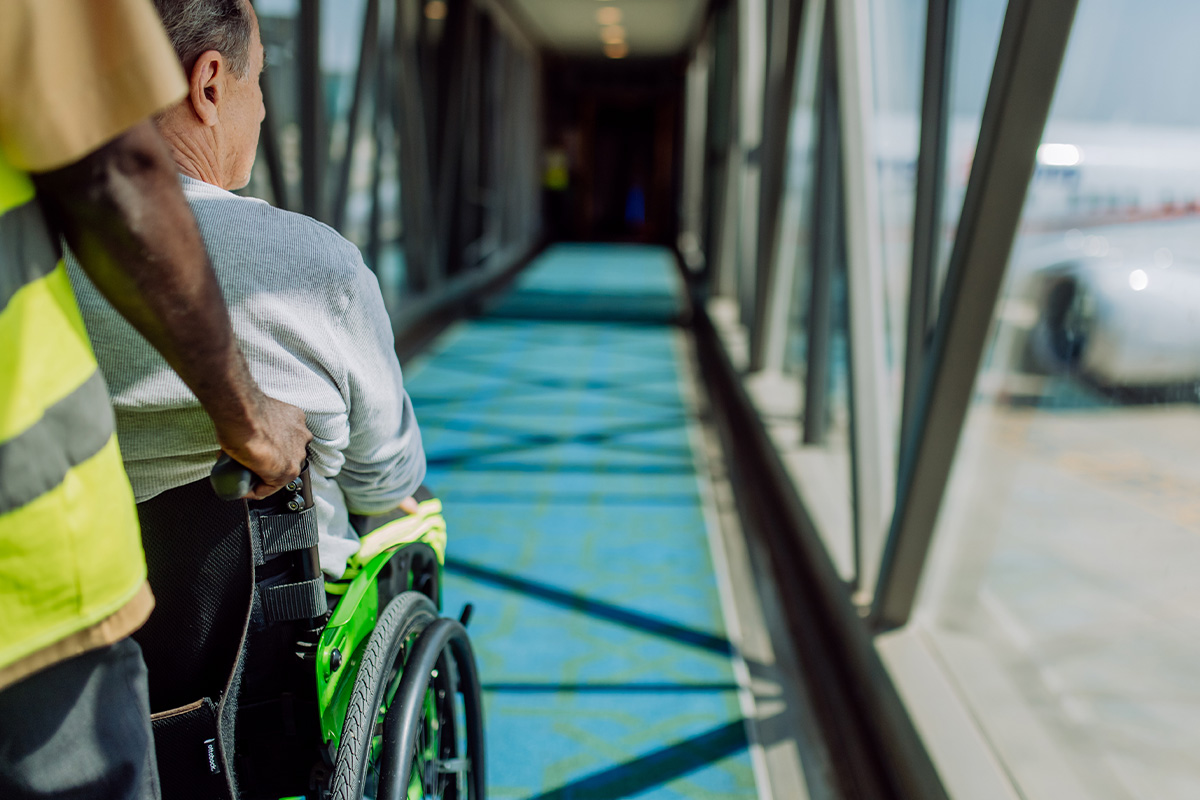Having Parkinson’s disease doesn’t mean you can’t travel.
Use this guide to learn how to properly plan and make a few adjustments to help you embark on your next journey!
First Things First — Consult Your Doctor Before Traveling
Start by scheduling an appointment with your doctor and neurologist well before your departure. Four to six weeks should give you ample time to talk through and plan for scenarios with your medical team. For example, your doctor can provide a list of referrals in your destination city should something come up while you’re out of town.
Plan Your Medications

Talk to your doctor to review your travel schedule carefully and ensure your bases are covered. Then, follow these tips to stay stress-free:
- If possible, keep all medications in their original containers with the labels affixed. Having medications in pill cases and keeping a list of your medications handy is also a great alternative.
- Store your medications in a carry on bag so you don’t have to worry if your luggage gets lost, destroyed, or delayed.
- Ensure your medication list is up-to-date with your doctor’s name and number. You also want all names, including generic and name brands, as well as dosage and frequency.
- Refrain from adjusting your medication time with changes in the time zone. Instead, maintain the same dosing schedule when traveling, especially on long train or airline flights, and use an alarm to remind you when to dose.
- Store at least one day’s dosage of medication in a fanny pack, pocket, or purse.
- Pack enough medication for your entire trip, including travel days, plus 3-5 extra days of medication. Don’t depend on foreign pharmacies to have your refills.
- Store light snacks and water to take medications.
Stay Hydrated

Hydration is critical, especially when facing new climates and shifts in your daily routine.
Here are a few ways to ensure proper hydration throughout your travels:
- Carry a portable water bottle with you so you can quickly fill up at water stations along the way.
- Use a chart or an alarm on your phone to remind you to drink fluids throughout the day. Aim for at least 32 ounces of water per day.
- Avoid dehydrating beverages like coffee or soda, and replace salty snacks (such as chips or pretzels) with more hydrating food options such as watermelon, strawberries, and celery.
Drinking fluids is critical for flushing toxins from your system, transporting important nutrients, and maintaining a healthy body temperature. Additionally, dehydration can exacerbate Parkinson’s symptoms, resulting in low blood pressure, constipation, or swallowing problems.
Keep on top of hydration while traveling so you can enjoy your trip to its fullest!
Parkinson’s Travel Packing Checklist

Here’s a checklist of what you’ll need to bring. Start with these essentials:
- Medication
- Identification stating that you have Parkinson’s disease
- Transportation tickets
- Government ID & Passports
- Medical Insurance Card
- Cash (determine a set amount for your trip)
- Credit cards (don’t bring all your cards, just one or two to get you by)
- COVID-19 vaccination cards (even if the destination does not require them, it’s better to be safe than sorry here as regulations can change often)
Pack Smart
Pack versatile outfits and make sure you can roll them up together in your luggage. Wear wrinkle-free elastic bands, pullover shirts, and slip-on shoes. The rules of travel never change—comfort above all else!
Use an over-the-door toiletry organizer for easy access once you reach your destination. If you need extra special equipment like a walker or cane, label it similarly to how you labeled your luggage. These unique items can easily be lost in the hectic shuffle of travel.
Pack Light
To make travel easier, pack only the essentials. Use light luggage like a simple carry-on with rolling wheels. If you must pack heavier, consider traveling with someone who can help you with stowing and lifting the suitcases.
Traveling Comfortably

Whether by air, land, or sea, here are general tips you should consider when traveling:
Request a Wheelchair
Train platforms and airport terminals are often large, long, and busy. Even if you don’t use one regularly, request a wheelchair or electric cart to help you move around in these spaces. You can book and reserve them in advance.
Get There Early
Avoid the stress and anxiety of rushing to your gates. Get to the airport or station at least 2 hours before your departure to beat the crowds. Remember to account for traffic on the way to the airport, especially during rush hours, weekends, and holidays.
Charge Up
Communication is key. Charge your phone before you leave the house. If you and your travel partner are separated, calling them will be less stressful with a full battery. Make sure they charge theirs, too.
Plus, you may need to make calls or look up info regarding changed planes.
Board First
Notify the boarding agent that you have Parkinson’s. They may board you and assist you to your seat earlier than everyone else.
Choose the Right Seat
Some travel options allow you to choose your seat. Pick one with the most legroom but never an emergency exit, as they don’t recline and require you to perform extra duties in the event of an emergency. Choose an aisle seat closest to the bathroom.
Flying with Parkinson’s (Airplane)

Flying comes with several challenges for those living with Parkinson’s:
- Airports can be large and confusing to navigate
- Seats can be uncomfortable with limited room for stretching and moving
- Delays and cancellations are more common than other modes of transportation
If you must fly, follow these additional tips for airplane travel:
- Request a special healthy or vegetarian meal to adhere to a healthy eating regimen.
- Book a non-stop flight when possible to avoid long layovers and transfers.
- Store your medications in your carry-on.
- Use wheelchairs and shuttles to reach far gates and terminals or request meet-and-assist services from the airline carrier.
- Your medical supplies or assistive devices do not count toward your carry-on and personal item limit.
- Listen up for early boarding and get settled before the remaining passengers.
Traveling by Ground with Parkinson’s (Car, Bus, Train)

Ground travel is a much better solution if you love watching the trees go by, meeting new people, and having substantially more legroom. Here’s a rundown of each of these options:
By Car
Driving on the open road can be a great adventure by yourself or with friends and family. If you’re driving solo, be mindful of the symptoms and side effects that may impact driving. Make sure you’re well rested before a long trip, and break up the drive into smaller drives.
Here is a list of upsides to traveling by car:
- Access to the radio
- Ability to adjust the seats and adjust the interior temperature
- Ability to roll down windows
- Ride with someone of your choosing (probably a care partner, family member, or friend)
- Fewer to no security protocols
- Ease of stopping, getting out, stretching, and visiting roadside attractions
By Train
Traveling by train can be an excellent way for people with Parkinson’s to see new places and meet new people. Trains offer ample opportunities to get up and walk around, which is essential for maintaining mobility. Plus, they provide a relaxed and comfortable environment, which can benefit people with Parkinson’s who sometimes feel anxious or overwhelmed in new surroundings.
Here’s a list of additional benefits of traveling by train:
- More stable than other modes of transportation, reducing the risk of falls
- Plenty of legroom
- Charming mode of travel
- Food options available
- Most Amtrak rails can accommodate wheelchairs
By Bus
Buses stop about every 3 hours for additional passengers coming on and current ones getting off. Most buses have wheelchair lifts and personnel to assist with your luggage.
They have more legroom than planes and usually have a bathroom in the back. You can also request to sit next to your care or travel partner.
Taking a Cruise with Parkinson’s

Cruises are fun and festive and have lots to offer people of all ages. However, they can also be quite unnerving for those with Parkinson’s.
For one, the security screening before you board your ship can be just as tight as air travel, largely because most of these trips venture into international waters. Have your papers in order and your meds in their appropriate containers.
The boat’s motion at sea can also be a challenge. Never leave your cabin without a care partner or cruise-provided assistance to help you remain steady.
Most cruises should be wheelchair accessible, but check ahead to confirm. You may need special permits or documentation for motorized assisted devices. Also, consider getting an “accessible” or “modified” stateroom before you book.
Explore PD-Friendly Travel Opportunities

Having Parkinson’s doesn’t mean sacrificing adventure; organizations like PasstoPass provide an outlet for fun in a safe and accepting space.
PasstoPass provides multi-day supported backpacking trips across the West Coast for people with PD. These trips are planned and led by people with PD (or with close connections to PD) so that routes, trails, and distances account for the needs of hikers with Parkinson’s.
Options like these allow people with Parkinson’s to nurture their spirit of joy, adventure, and exercise in a more controlled setting, creating a tailored experience.
See all PasstoPass has to offer for the remainder of 2024 here.
Top 5 Travel Takeaways from the PCLA Community

PCLA recognizes that traveling with PD can be tricky, especially when it comes to air travel for lengthy periods of time.
Luckily, several seasoned pros on the PCLA team have years of experience traveling with Parkinson’s disease. Thank you to Gail Buckley and Travis Robinson for providing their insight!
Here are their TOP FIVE TIPS for traveling with PD:
1. Be prepared.
Pack strategically so you have extras of the necessities (medications, proper footwear, weather-appropriate clothing, etc.) If you use a walker, ask for wheelchair assistance for all the legs of your trip in advance.
2. Be flexible.
Remember that wherever you go, it’s not your home and will be different.
3. Be agile.
Prepare to make small changes quickly and without a fuss.
4. Be situation aware.
When did you last eat, medicate, or use the toilet?
Keep track of these simple but important questions! Even letting one thing slip can cascade into a stressful situation.
Set alarms, travel with a buddy, and pay attention to what is happening inside and outside your body.
5. Be assertive.
Don’t be afraid to tell others what your needs are.
Most of the time, people are happy to accommodate you.
Flying? Tell the flight attendant you’ll need to move around so they don’t tell you to sit down.
Need more time to get to your destination?
Need to take a rest when you do?
Don’t be shy. Ask for it.
This is particularly important when visiting folks who need to become more familiar with PD or who you last saw a while ago. Let them know how you are now, not how you used to be.
Next Steps
Traveling with Parkinson’s can be fun, exciting, and adventurous.
Beyond the tips we’ve shared above, the most important thing to remember is to keep to your routine. Have a great time, but also be mindful of your medications and mental and emotional health.
If you need guidance on anything we’ve shared today, feel free to reach out to us, we’d be happy to connect you with additional support and resources.



0 Comments